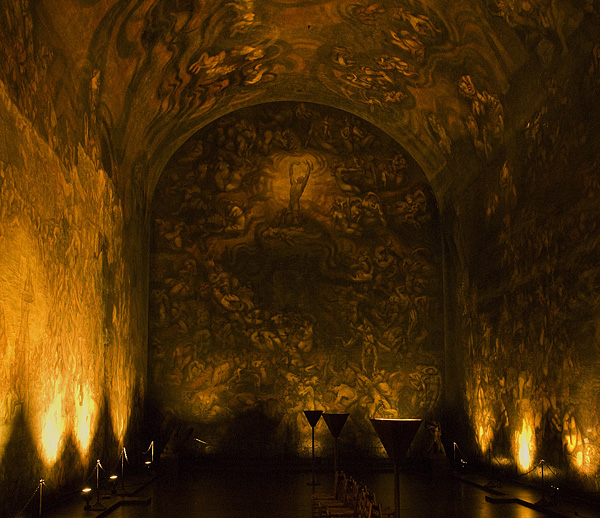In Sonic Wonderland/The Sound Book, I wrote about the Emanuel Vigeland Mausoleum in Oslo, Norway. It was recommended to me by Norwegian acoustician and composer Tor Halmrast who told me it was the most reverberant place for its size that he had ever met. When I was in Oslo last week, I took the chance to experience this remarkable place first hand.

Every surface of the tall barrel-vaulted room is covered with frescos. It is even gloomier than the picture above shows, with the walls being very dark. The walls and ceiling are covered in every aspect of life from conception to death, including some extremely explicit images. My favourite was above the door, where a plume of babies rise above a pair of skeletons reclining in the missionary position.
Tor was right, the space is incredibly reverberant. Sing a note and it takes about 10 seconds to die away. It is also a very pleasant reverb, it seems like the sound gently cascades down onto you from the arched roof above. No wonder this place is regularly used by musicians.
https://www.youtube.com/watch?v=tVgfPpVxdZ0?start=55s
To measure the acoustics, I recorded a balloon burst on a digital recorder, and later analysed the recording to calculate the reverberation time, which is a measure of how long it takes a sound to decay by sixty decibels. Here is one of the balloon bursts:
You can download the balloon bursts in wav format from freesound.org

Tor was right, the Emanuel Vigeland Mausoleum is unusually reverberant for its size. This happens because every surface is granite or concrete. Importantly, there are no longer any windows that would otherwise vibrate and allow the sound to escape to the outside. Also, the frescos are sealed with wax, so they have clogged up the pores of the concrete walls.
A visual and aural treat, and definitely worth visiting if you’re in Oslo. If you do, try dragging one of the chairs across the floor.
Notes
[0] Photo credit: http://www.emanuelvigeland.museum.no/museum.htm
[1] The reverberation time graph is an average of three balloon bursts taken from roughly the same place in the mausoleum (I don’t know why I didn’t use three very different places!)
[2] This is longer than the reverberation time given in Sonic Wonderland/The Sound Book, which was based on measurement by others.
6 responses to “Extreme acoustics in the Emanuel Vigeland mausoleum”
Would love to visit this place…
It ‘ll be very interesting to know dimensions of the hall and thicknesses of floor, ceiling and wall. I heard, that in old manuscripts about Egypt old halls and palaces there were many closed caverns inside walls and ceilings to improve sound power and reverberation times. I know the same practic at some churches in Russia. It’s interesting to know, did anybody investigate the wall surface to discover, maybe, any holes in it?
The walls are made of cast concrete, probably about 40cm thick. The floor is granite tiles. The room is 20x10x12.5m It is arched.
You can find holes in churches and mosques from medieval times. There are usually not enough to affect the acoustics significantly.
When I said about holes in walls I’ve paid attention at possible location for caverns inside walls but holes as well. Such a dimensions (it could be simulated by well-known codes: Odeon, EASE for instance) can not cause so big reverberation time like this, I mean. From other hand, I know some churches with masonry walls with such a Helmholz resonators inside, made from big ceramic buttles. That’s why this assumption take place here.
The capability of acoustic engineers astounds me at times. I can only imagine that they nowadays use very sophisticated programs to help them configure interiors properly for maximal acoustic capability. That this sort of precision was possible before computers is just remarkable in my eyes.
I attended a concert here entitled, “Gong Bath with didgeridoo” that was astounding. The concert started with the male and female performers singing in harmony. Chills went down our spines. Gongs, bowls, bells, woodwinds, stringed instruments, the experience was sublime. At the end the performers walked among us ringing small bells. We didn’t want it to end. If you ever have a chance to attend one of these performances, GO! They seem to do them several times each year.